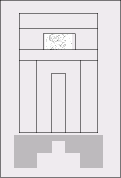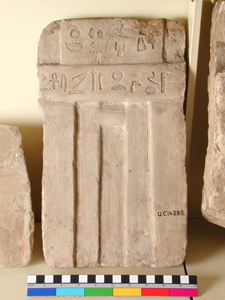| Homepage | Timeline | Maps | A-Z index | Learning |
The false door
The most important part of an Old Kingdom mastaba was the false door.
Already earlier, in Tarkhan mastaba 1060, one of the niches is specially painted in red. It is very likely that this was a place where the cult for the dead was performed.

Many mastabas of the Second to Fourth Dynasty present on their west side two niches. These are clearly for the cult of the dead (for the tomb owner and his wife). The stelae of that time might have been placed in such niches.

|
examples
|
|
In the Third and Fourth Dynasty the niche was replaced by a small room, with a decorated niche at the back.

|
examples
|
||
The classic false door combines the niche of a palace facade with the image of the dead sitting in front of the offering table. The false door is very common in mastabas of the Old Kingdom (about 2686-2181 BC) and the First Intermediate Period. After that period it becomes rare.

 |
The false door of Meresankh; Old Kingdom (about 2686-2181 BC). This example is unusual in that it has no picture of the dead sitting in front of the offering table. UC 14288 Stewart 1979: 35, no. 150, pl. 36.6 |
other examples of false doors in the Petrie Museum (most are only fragments)